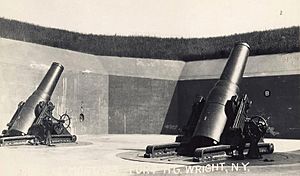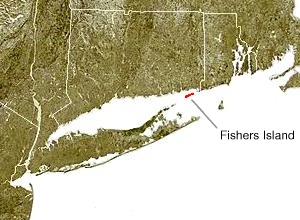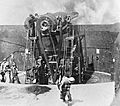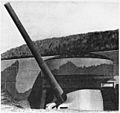Fort H. G. Wright facts for kids
Quick facts for kids Fort H. G. Wright |
|
|---|---|
| Part of Harbor Defenses of Long Island Sound | |
| Fishers Island, Southold, New York | |

12-inch mortars, Battery Clinton, Fort H. G. Wright
|
|
 |
|
| Coordinates | 41°15′13″N 72°01′49″W / 41.25361°N 72.03028°W |
| Type | Coastal Defense |
| Site information | |
| Controlled by | private/Town of Southold |
| Open to the public |
partly |
| Site history | |
| Built | 1898–1906 |
| Built by | United States Army |
| In use | 1898–1958 |
| Battles/wars | World War I World War II |
| Garrison information | |
| Garrison |
|
Fort H. G. Wright was a military base in the United States. It was located on Fishers Island, which is part of Southold, New York. This island is only two miles from the coast of southeastern Connecticut, but it belongs to New York state.
The fort was a key part of the Harbor Defenses of Long Island Sound. It worked with other forts like Fort Terry, Fort Michie, and Camp Hero to protect the eastern entrance of Long Island Sound. This defense was important for protecting Connecticut's ports and the northern shore of Long Island. The fort was named after Union General Horatio G. Wright, who was a famous engineer born in Clinton, Connecticut.
Fort H. G. Wright was first built in the early 1900s. It was actively used during both the First World War and the Second World War. After World War II, it was no longer needed for coastal defense and was closed down.
Contents
History of Fort H. G. Wright
Building the Fort and its Guns
Fort H. G. Wright was built as part of a big plan called the Endicott Program. This plan aimed to replace older coast defenses with new, stronger ones. The Army Corps of Engineers designed and built these forts. The Army Ordnance Corps designed the weapons. By 1907, soldiers from the Coast Artillery Corps were stationed at the forts.
Fort H. G. Wright became the main base for the Coast Defenses of Long Island Sound. Building the gun batteries at the fort began in 1898. By 1906, many batteries were finished. Here are some of the main ones:
| Name | Number of Guns | Gun Type | Carriage Type | Years Used |
|---|---|---|---|---|
| Dynamite | 1 | 15-inch (381 mm) dynamite gun | pedestal | 1898–1904? |
| Clinton | 8 | 12-inch (305 mm) mortar M1890 | barbette M1896 | 1902–1943 |
| Butterfield | 2 | 12-inch (305 mm) gun M1895 | disappearing M1897 | 1901–1945 |
| Barlow | 2 | 10-inch (254 mm) gun M1895 | disappearing M1896 | 1901–1943 |
| Dutton | 3 | 6-inch (152 mm) gun M1897 | disappearing M1898 | 1902–1944 |
| Hamilton | 2 | 6-inch (152 mm) gun M1903 | disappearing M1903 | 1905–1917 |
| Marcy | 2 | 6-inch (152 mm) gun M1903 | disappearing M1903 | 1906-1917 |
| Hoffman | 2 | 3-inch (76 mm) gun M1902 | pedestal M1902 | 1905–1945 |
| Hoppock | 2 | 3-inch (76 mm) gun M1903 | pedestal M1903 | 1913–1946 |
The fort also had facilities for an underwater minefield. This minefield would help stop enemy ships. Battery Dynamite had a special 15-inch gun that fired dynamite. This type of gun was later found not to be as good as regular cannons and was removed in 1904.
Interestingly, some of the fort's largest guns were replaced between 1911 and 1914. This was probably because the fort was often used for live-fire practice. Its location offshore made it a good place for this.
Fort H. G. Wright in World War I
When the United States joined World War I in April 1917, changes were made at forts across the country. The Coast Artillery Corps, which ran the forts, also operated most of the heavy artillery used by the US in France. Many soldiers from the forts were sent to fight on the Western Front.
In 1917, four 6-inch guns from Batteries Hamilton and Marcy were taken from the fort. They were put on special carriages and sent to France. However, these guns did not see action before the war ended. Also, four of Battery Clinton's eight 12-inch mortars were removed in 1918. This was done to make reloading faster. Some of these mortars were turned into railway artillery, which are guns on train cars. None of the removed guns at Fort H. G. Wright were replaced.
Between the World Wars
In 1924, the Coast Artillery Corps changed how it was organized. The 11th Coast Artillery Regiment was created for Long Island Sound. Its main base was Fort H. G. Wright. The 242nd Coast Artillery Regiment from the Connecticut National Guard served as a backup.
Between 1936 and 1937, the fort's 10-inch and 12-inch guns were replaced again. This was likely still due to their use in live-fire training. Battery Barlow's 10-inch guns were replaced in 1936. Battery Butterfield's 12-inch guns were replaced in 1937. Battery Barlow was closed in 1939, and its guns were removed in 1943. An anti-aircraft battery, likely with 3-inch guns, was built in the 1930s to shoot down enemy planes. The fort also had an airfield, which included a balloon hangar from 1920 to 1962.
Fort H. G. Wright in World War II
From 1940 to 1944, the 11th Coast Artillery and the 242nd Coast Artillery Regiment defended Long Island Sound. During World War II, the main defense plan for Long Island Sound changed. Two very large 16-inch gun batteries were built at Camp Hero in Montauk. These new, powerful guns made all the older, smaller guns in the area less important.
Because of this, Fort H. G. Wright's 10-inch and 12-inch guns, 12-inch mortars, and some 6-inch guns were removed between 1943 and 1945. As most of the weapons were taken away, the larger artillery regiments were replaced by smaller battalions in 1944.
Fort H. G. Wright did get some new batteries during the war. However, the biggest guns for these new batteries were never actually put in place. This was because the threat from German ships had become very small by 1943. A 16-inch gun battery (No. 111) was finished in 1944, but its guns were never mounted. Two 6-inch gun batteries were built, but only one was armed. The Navy also used the fort's airfield for blimps during the war. A special Navy school on the island taught how to detect submarines using "indicator loops."
Here are some of the new batteries built during World War II:
| Name | Number of Guns | Gun Type | Carriage Type | Years Used | Notes |
|---|---|---|---|---|---|
| 111 | 2 | 16-inch (406 mm) Navy gun MkIIMI | barbette | 1944–1947 | Guns delivered but not mounted |
| 215 | 2 | 6-inch (152 mm) gun M1903 | shielded barbette | 1943–1946 | At Race Point |
| 214 | 2 | 6-inch (152 mm) gun M1 | shielded barbette | Not armed | At Wilderness Point, never armed |
| Hackleman | 2 | 3-inch (76 mm) gun M1903 | pedestal M1903 | 1944–1946 | Guns from Fort Constitution |
| AMTB 913 | 4 | 90 mm gun | two fixed, two towed | 1943–1946 | In front of Battery Butterfield |
| AMTB 914 | 4 | 90 mm gun | two fixed, two towed | 1943–1946 | At Goshen Point (mainland) |
| AMTB 915 | 4 | 90 mm gun | two fixed, two towed | 1943–1946 | At Pine Island |
| AMTB 916 | 4 | 90 mm gun | two fixed, two towed | Not built | At East Point |
The Anti-Motor Torpedo Boat (AMTB) batteries were designed to fight both enemy ships and aircraft. They were also supposed to have two 40 mm Bofors guns each.
After the War
After World War II, it became clear that large gun defenses were no longer useful. New weapons like missiles and aircraft made them old-fashioned. The fort was officially closed in 1947, and all its guns were removed in 1948. In 1949, the Naval Underwater Sound Laboratory opened a research center on the island.
Fort H. G. Wright Today
Many of the fort's larger gun batteries still exist today. For example, Battery 214 was used as a private home in the 1990s. The old military airfield is now a regular airport for civilian planes. You can still see the round metal base for Battery Dynamite's 15-inch gun. This is likely the only one left of its kind.
Some batteries, like Butterfield, Barlow, and Dutton, were used as a dump for yard waste in the 1990s. Some buildings that were part of the minefield operations were later covered with concrete and earth. In the 1990s, this bunker was used to store grass because it stayed cool and damp inside. Most of the fort's old office and living buildings are still there. They have been changed and are now used for other purposes.
Gallery








